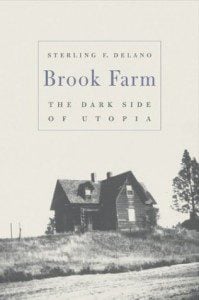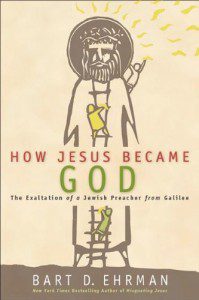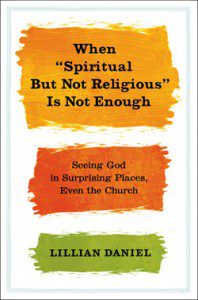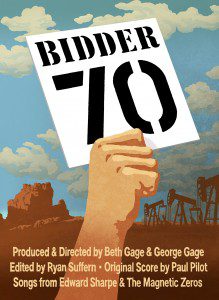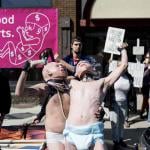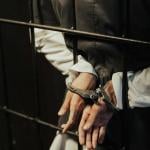The Second of Unitarian Universalism’s Six Sources is “Words and deeds of prophetic women and  men which challenge us to confront powers and structures of evil with justice, compassion, and the transforming power of love.” In that spirit, I want to share some stories about Rabbi Abraham Joshua Heschel (1907-1972).
men which challenge us to confront powers and structures of evil with justice, compassion, and the transforming power of love.” In that spirit, I want to share some stories about Rabbi Abraham Joshua Heschel (1907-1972).
Rabbi Heschel was one of the great prophetic figures of the twentieth-century. To many observers, it was as if one of the biblical prophets had been reborn in our own day. Instead of having the safe distance of reading an ancient prophetic text condemning the injustices of centuries ago, Heschel was a living human being calling out the injustices in our society, and calling us to change. But let me start at the beginning.
One of the most formative influences on Heschel’s life was being an 8th-generation Hasidic rabbi. Moreover, his ancestors were not just any line of rabbis; his family had been highly influential since the beginning of the Hasidim. You may be familiar with the name Baal Shem Tov (1698-1760), who in the 18th-century founded the Hasidic movement, a mystical branch of Judaism. And when he died, one of Rabbi Abraham Joshua Heschel’s ancestors — Rabbi Heschel of Apt — “became the spokesperson for their Hasidic generation.”
Had circumstances been different, our Rabbi Heschel would likely have continued in his ancestor’s footsteps, either as a rabbi or as a professor in Europe. Instead, as a Jew coming into adulthood in Poland, Rabbi Heschel life changed drastically with Hitler’s rise to power. One of the first major changes Heschel had to confront was that, although he was a brilliant student, the academic system he was in required that doctoral students not only complete, but also publish that dissertation as a book to earn their Ph.D. And he was seeking to publish his first book — which was explicitly about the Hebrew prophets — in a climate that was growing increasingly hostile to all things Jewish. Indeed, the letter he received in December 1935 from his dean at the University of Berlin, granting him an extension on finding a publisher, was signed with an ominous “Heil Hitler!” above the signature.
The growing Anti-Semitism of the time led Heschel to immigrate to the United States in 1940, where he was hired to teach first at Hebrew Union College in Cincinnati, then at Jewish Theological Seminary in New York. In retrospect, knowing the world-historical, beloved figure he became, it’s fascinating to note that students didn’t always respond well to him in the classroom, especially in the early years. The primary reason was cultural:
In European Universities, students would rise when the professor entered the classroom. (In fact, members of Heschel’s Hasidic community in Warsaw used to rise when he, the Hasidic prodigy, entered the room.) Teachers sat at a desk and lectured from notes without looking up, while students silently noted the material being presented to them. American students, however, expected to interact with their teachers, and they expressed themselves freely.
Furthermore, Heschel tended to teach not through a standard, linear lecture format, but with digressions, which the American students often couldn’t follow because Heschel was so familiar with Jewish texts which many of the students had only a passing familiarity.
Heschel also had the habit of some European professors of not preparing an original lecture, and instead reading from whatever piece of his own writing he was currently working on — which would include pausing the write in corrections that occurred to him as he read aloud. At the same time, it should be noted that throughout his career, he would spend hours with students who resonated with his work, “inviting them to his office for probing conversations, advising them on personal problems, and nursing their spiritual growth.”
And as boring as his early lectures apparently were, his prophetic voice would periodically emerge in a way that could left a lasting impression on those present. For example, in the wake of an involved discussion about whether gelatin is kosher, Heschel interjected with the question, “can you tell me if the atomic bomb is kosher?”
As you can see, early on Heschel had a particular talent for seeing the contemporary analogies to sacred scripture. And as he became more aware of this part of himself, it is fascinating to see how he began to cultivate this aspect, especially in his outward appearance. For instance, if you look at the author’s photo on the dusk jacket of his first major book Man Is Not Alone, published in 1951, Heschel looks like he could easily pass as a character on Mad Men. At age 44, he’s fresh-faced and clean-shaven with short, wavy, dark hair, wearing a dark suit and wire-rim glasses. By the late 50s, he has grown a goatee and his hair is gray. And in the 60s, as he became increasingly well-known as an interfaith activist for social justice, he came into his own in his external appearance, fully owning the image of sagacious rabbi meets Hebrew prophet. And just as Kennedy’s youthful appearance buoyed his public perception, so too Heschel’s long, flowing white beard and Einstein-like wild mane of white hair similarly made for incredible photo ops that helped garner publicity for social justice causes when Heschel made an appearance.
Most famously, a United Press International photographer took an iconic picture of Rabbi Heschel marching arm-in-arm with Dr. King and other prominent civil rights activists on the Selma to Montgomery March in 1965. (That’s the same march in which 38-year-old Unitarian minister James Reeb was beaten to death, and became a martyr for the Civil Rights movement. Dr. King delivered Reeb’s eulogy.) Heschel famously said about that day that, “the march was about protest and prayer. Legs are not lips and walking is not kneeling. And yet our legs uttered songs. Even without words our march was worship. I felt my legs were praying.” Heschel, King, and so many more put their life on the line, and in particular that image of them marching together became “an icon of the civil rights movement and testimony to the black-Jewish coalitions of the 1950s and 1960s.” And when King was assassinated three years later, Coretta Scott King invited Rabbi Heschel to read these words from the prophet Isaiah at King’s funeral: “He was despised and rejected by men; A man of sorrows, and acquainted with grief; And as one from whom men hid their faces. He was despised, and we esteemed him not.”
I should also add that Rabbi Heschel and Dr. King’s friendship and joint activism did not end with the Civil Rights Movement. Another iconic photo of Dr. King and Rabbi Heschel was taken in 1968 at the Tomb of the Unknown Solider to protest the U.S. involvement in the Vietnam War. After that picture appeared, Heschel was criticized by Orthodox Jews because in the photo, between Heschel and King, was a fellow Rabbi carrying a Torah — and certain interpretations forbid bringing a Torah into a cemetery. But Heschel, having been raised deeply immersed in Hasidic Judaism, was more than ready to meet this objection — and promptly replied with a six-point defense of his choice. But more important than any of these reasons was Heschel’s actual motivation, which was a keen sense that he sometimes had for public relations. And when he heard that the Christians were going to bring a processional cross to that interfaith protest at Arlington National Cemetery, he knew it it would look much worse for Jews to be photographed marching behind a cross. So he boldly made the decision to bring a Torah.Heschel knew that theatrics and optics can make all the difference in turning public opinion for or against a social justice movement.
Speaking of interfaith activism, Rabbi Heschel was also heavily involved in Jewish-Catholic dialogue, particularly around the Second Vatican Council in the early 60s, which was a tremendously liberalizing shift in Roman Catholicism. Rabbi Heschel was quite successful in developing a collegial working relationship with one of the main Cardinals involved with writing the Vatican II document regarding Jews,although he did not find a sympathetic ear with Pope Paul VI. (The more progressive Pope John XXIII, who convened the council, had died a year earlier.) In the midst of Heschel’s advocacy with Catholic hierarchy, his prophetic zeal sometimes showed itself stridently. One of the most prominent examples is when he said, “As I have repeatedly stated to leading personalities of the Vatican, I am ready to go to Auschwitz any time, if faced with the alternative of conversion or death.”As I understand it, his point was that after the Holocaust, the importance of Christians changing their understandings of Jews had to change. And due to Rabbi Heschel’s involvement, the final Vatican II documents were likely more open and inclusive toward Judaism than they would’ve been otherwise.
And as I think about this mid-twentieth-century Jewish prophet calling the Christian church to reform, I can’t help, but think about the recent 84-page apostolic exhortation written by Pope Francis. To read just one short description from The New York Times, “Pope Francis attacked unfettered capitalism as ‘a new tyranny’ and beseeched global leaders to fight poverty and growing inequality. Francis went further attacking the ‘idolatry of money’, and urged politicians to ‘attack the structural causes of inequality’ and strive to provide work, healthcare and education to all citizens.” When I posted on social media about this document, one of my friends joked, “So, if Obama is a communist for proposing stuff that’s far less far-reaching, then what does that make Pope Francis?” When I saw his comment, the only reply I could think of was that it makes Pope Francis not a communist, but “a Christian…a Jesus follower” — because he’s actually doing what Jesus might do if he were alive today.
Along these lines, I sometimes have a similar thought about Rabbi Abraham Joshua Heschel: that through him we have a glimpse of what it would look like if one of the Hebrew prophets or if Rabbi Jesus had lived in the U.S. in the twentieth-century. After all, Jesus was both Jewish and a rabbi. Jesus is explicitly called a rabbi in the New Testament, and Jesus was not a Christian. Historically-speaking, of course, even Paul wasn’t a Christian, but that’s the topic of another post! In contrast, Rabbi Jesus lived and spoke out of the Hebrew prophetic tradition, as did Rabbi Heschel, as did Dr. King. And our invitation is to look for and listen to the prophetic voices today from Wendell Berry to Thich Nhat Hanh to Aung San Suu Kyi, to the late Nelson Mandela. As Rabbi Heschel said in an interview, “the spirit of the prophet, the message of the prophet, is very much alive. The kind of men [and women] who combine very deep love, very powerful dissent, painful rebuke, with unwavering hope.”
And in speaking about how the prophetic sensibility leads one to be deeply moved and involved in both feeling and crying out again the pain of the world, Rabbi Heschel famously said that, “The opposite of good is not evil, the opposite of good is indifference.” As terrible as evil acts can be, Heschel challenges us to consider that apathy can be even worse; indeed, apathy is what allows evil to prosper and spread.
And it would’ve been enough if Rabbi Heschel’s heart had been broken by the Holocaust in a way that would have lead him to fight against future anti-Semitism through efforts like his dialogues with the Catholic Church. But more remarkably — and the reason he became a prophetic figure on the world stage — is that Heschel’s heart was broken open not only for all Jewish people, but also for all people. To give one among many examples:
A journalist once asked [him] why he had come to a demonstration against the war in Vietnam. “I am here because I cannot pray,” [he] said. Confused and a bit annoyed, the journalist asked him, “What do you mean, you can’t pray, so you come to a demonstration against the war?” And [he] replied, “Whenever I open the prayerbook, I see before me images of children burning from napalm.” Indeed, we forfeit the right to pray…if we are silent about the cruelties committed in our name by our government. In a free society, some are guilty but all are responsible. How dare we come before God with our prayers when we commit atrocities against the one image we have of the divine: human beings.
Those words are deeply resonate with the UU First Principle, “The inherent worth and dignity of every person.”
I should also add that that last story is told about Rabbi Heschel by his only child, a daughter, named Susannah Heschel, who a professor of Jewish Studies at Dartmouth College. And in that crucial test of whether renown public figures are also admired by their family, Rabbi Heschel also succeeded. Dr. Susannah Heschel writes about he father that,
Although raised in a very traditional, gender-differentiated pietistic home, my father recognized that aspects of Judaism had to change, particularly for women. He asked me to lead prayers for the table, and he even suggested that I consider becoming a Conservative rabbi, at a time when women’s ordination seemed highly remote. I was the first daughter of my parents’ circle to have a Bat Mitzvah celebration at a synagogue on Shabbat morning, at my request, and my parents were fully supportive. My father used to say that while he was expected to become a Hasidic rebbe, he felt the world needed something different from him — and Jewish women needed more as well.
There is, of course, much more to say about Abraham Joshua Heschel’s life, such as his remarkable friendship with Reinhold Niebuhr in the final years of Niebuhr’s life. Niebuhr, you may recall, was arguably the most famous and influential Christian theologian of the twentieth-century. And as testimony to their close friendship, when Niebuhr (the world-famous Christian theologian) died in 1971 at age seventy-eight, the Jewish Rabbi Heschel was invited to give the only eulogy.
Rabbi Heschel himself died the next year in 1972 at the far too young an age of 65. And surrounding his death, there is a classic story that
two books lay on Heschel’s night table, David Halberstam’s exposé of Nixon’s war cabinet, The Best and the Brightest, and the Keter Shem Tov, a Hasidic classic…. However, Sylvia Heschel [his wife] admitted to a friend that she had deliberately positioned the books there, replacing the Newsweek…which Heschel had been reading…. The mythologizing of Heschel had begun.
If you have been intrigued by the life of this 20th-century Hebrew prophet, I encourage you to learn more about Rabbi Abraham Joshua Heschel, and to allow his life to inspire your work for justice today. But for now, I will leave you with Heschel’s own words in response to a interviewer who asked him what message he would say to young people if he only had one minute. Rabbi Heschel replied,
I would say let them remember that there is a meaning beyond absurdity. Let them be sure that every little deed counts, that every word has power, and that we [must] do…our share to redeem the world, in spite of all absurdities, and all the frustrations, and all the disappointment. And above all, remember that the meaning of life is to live life as if it were a work of art.
Notes
- “became the spokesperson for the their Hasidic generation.”— Edward Kaplan and Samuel Dresner,” Abraham Joshua Heschel: Prophetic Witness, 5.
- “Heil Hitler!” above the signature — Prophetic Witness, 178, 199.
- In European Universities, students would rise — Edward Kaplan, Spiritual Radical: Abraham Joshua Heschel in America, 1940-1972, 39.
- “inviting them to his office for probing conversations” — Spiritual Radical, 87.
- “can you tell me if the atomic bomb is kosher?” — Spiritual Radical, 132.
- At age 44, he’s fresh-faced and clean-shaven — Spiritual Radical, 118
- By the late 50s, he has grown a goatee and his hair is gray. — Spiritual Radical, 176
- Heschel’s long, flowing white beard and Einstein-like wild mane — Spiritual Radical, 223
- Susannah Heschel, “Praying with Their Feet: Remembering Abraham Joshua Heschel and Martin Luther King,” PeaceWork, Issue 371: December 2006 – January 2007, 2.
- “testimony to the black-Jewish coalitions of the 1950s and 1960s.” — Spiritual Radical, 223
- Coretta Scott King invited Rabbi Heschel to read — Spiritual Radical, 328-9
- boldly made the decision to bring a Torah. — Prophetic Witness, 324
- working relationship with one of the main Cardinals — Spiritual Radical, 242-3
- “I am ready to go to Auschwitz any time, if faced with the alternative of conversion or death.” — Spiritual Radical, 260.
- due to Rabbi Heschel’s involvement, the final Vatican II documents — Spiritual Radical, 276
- A journalist once asked [him] why he had come to a demonstration against the war — Abraham Joshua Heschel: Essential Writings (Modern Spiritual Masters), 17.
- Although raised in a very traditional, gender-differentiated — Essential Writings, 42.
- invited to give the only eulogy — Spiritual Radical, 354.
- two books lay on Heschel’s night table — Spiritual Radical, 377-378.
The Rev. Dr. Carl Gregg is a trained spiritual director, a D.Min. graduate of San Francisco Theological Seminary, and the minister of the Unitarian Universalist Congregation of Frederick, Maryland. Follow him on Facebook (facebook.com/carlgregg) and Twitter (@carlgregg).
Learn more about Unitarian Universalism:
http://www.uua.org/beliefs/principles



